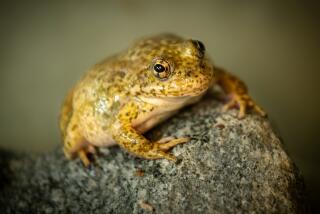Global warming endangers California birds, study says
More than a third of native California bird species could vanish from a wide swath of their current range by the end of the 21st century because of global warming, according to a new study by Audubon California.
From the puffy-chested California gnatcatcher, which could lose more than half of its Southern California range, to the Central Valley’s yellow-billed magpie, which could disappear across 70% of its current habitat, about 110 species are likely to be pushed into new territory, according to Audubon scientists.
“Future climate change threatens California’s birds with massive range reductions and, in extreme cases, statewide extirpations and global extinctions,” asserted William B. Monahan and Gary Langham, authors of the paper.
The California projections came as the National Audubon Society released the most comprehensive study ever done on dramatic shifts in the range of birds nationwide, based on 40 years of data from its annual Christmas bird count. The count is a massive effort in which 50,000 volunteers nationwide record the numbers of birds at 2,000 locations.
Now computerized, the data show that 58% of the 305 most common North American species have shifted their ranges northward and inland by an average of 35 miles in the last 40 years. Some of the shifts have been extreme: the purple finch, once most common in Missouri, moved more than 300 miles north, toward Canada.
In California, more than 100 species have moved significantly north. The red-breasted nuthatch, the house finch, the pine siskin and the varied thrush all shifted their range more than 200 miles. The golden-crowned sparrow and the California quail have moved more than 100 miles.
“Too many people hear about melting glaciers and polar bears and conclude that the impacts of global warming are far into the future and far from home,” said John Flicker, president of the National Audubon Society. “But the impact of climate change can be seen right now in the birds that are right outside our door -- or not.”
In the last century, average global temperatures have increased by 1.4 degrees Fahrenheit, but depending on how successful governments are at lowering greenhouse gas emissions, scientists expect an increase between 4 and 11 degrees Fahrenheit by 2100.
The Audubon studies have yet to be published in peer-review journals, but the authors said they would be in the future. Audubon officials said the early release was an effort to build support in Congress for legislation to control greenhouse gases, the planet-heating emissions that come from automobiles, power plants and other industries.
The studies also come as states are struggling with how to help wildlife adapt to climate change, for example by establishing corridors to shifted habitats or setting aside refuges in new areas. A California government task force is expected to issue a far-reaching report next month on how the state should adapt to water shortages, rising sea levels and droughts that could result from climate change.
Although Audubon’s national study found that a majority of birds had shifted their ranges north over the last four decades, about a quarter of the species studied moved south. Birds can shift ranges because of sprawl, agriculture or interaction with other species, the scientists pointed out.
A majority of grassland species, such as the western meadowlark, prairie falcon, burrowing owl, and savannah sparrow, have failed to move because their native grasses have disappeared leaving them no refuge, the report said.
Several tundra species are endangered by their shifts: The snowy owl and the American golden-plover have moved about as far north as they can. And coastal seabirds such as Kittlitz’s murrelet and the ashy storm petrel would be severely threatened by rising sea levels.
However, of the 177 species that moved significantly north, 76 increased in population, including such Western birds as the golden-crowned sparrow, the chestnut-backed chickadee and Steller’s jay, the researchers said.
The California study, which projected future ranges, showed large variations in the possible shifts, based on the levels of greenhouse gas emissions in the future and how species might adapt to change. The California gnatcatcher, for example, could lose from 7% to 56% of its current range, and the chestnut-backed chickadee between 16% and 49%.
The researchers produced detailed maps of the ranges for 310 native California species based not only on 40 years of Audubon data and U.S. Geological Survey data, but also on 19 climate-related variables, including temperature and rainfall, assembled by Oregon State University researchers.
Terry L. Root, a Stanford biologist who studies the effect of climate change on wildlife, said there have been similar studies showing that climate change is having an effect on various species of birds across the globe, but that the Audubon study is “unique in looking at all the wintering birds on an entire continent.”
She said a critical effort must go forward to protect the boreal forests of Alaska and Canada, where many of the birds that move north will take refuge. “We want to make sure they have some place to live,” she said. “We are going to be losing species.”
--






